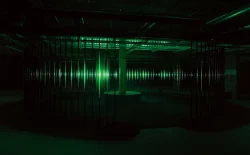Before the release of Beauty Behind the Madness, Abel Tesfaye, bka The Weeknd, seemed like he was having an identity crisis.
A maestro of dejected, drug-addled mixtape R&B who couldn’t break the mold of his impressive debut House of Balloons with his inability to advance his sound on its two subsequent follow-ups Thursday and Echoes of Silence (later released in compilation as a full-length proper album called Trilogy), Tesfaye continuously dwindled in Balloons’s wake. His second LP Kiss Land further crumbled his good will, with its lackluster innovation: the title track, for example, recycled a Main Attrakionz beat. But with a feature on Ariana Grande’s ‘Love Me Harder’ and two major placements on the 50 Shades of Grey soundtrack, for which his efforts were devoid of the crestfallen filth we’ve come to expect from Tesfaye, a crossover narrative began to develop. This was only buttressed by the pop appeal of his summer hit ‘Can’t Feel My Face’, a thinly veiled ode to cocaine which landed him a stateside stadium tour and a place on MTV’s VMA stage.
Beauty Behind the Madness should be brimming with subtle sexuality and drug allusions that would function as a wink to his day-one fans, but keep him chaste enough to propel him into fully-realized pop star. But the greatest trick the devil ever pulled was convincing the world he did not exist and only three songs into Madness, the pussy-and-pills Tesfaye unfurls on the Soul Dog-sampling, Kanye West-produced ‘Tell Your Friends’. When he sings, “Now money is the only thing I’m chasing / And some dope dimes on some coke lines… Baby girl just wants to smoke a pound / Do an ounce, get some dick, tell her friends about it,” it’s not just standard issue groupie prattle. Here is our first confirmation that the mission statement has never changed, Tesfaye has just finessed a way to bring it to a much, much larger audience. The instruction to ‘go tell your friends about it’ isn’t because he’s cool with cock gossip, it’s more meta than that. Having it come in after two softball intro tracks, it also functions as a territorial flag signaling that his signature brand of debauchery is afoot and that you don’t need to sign an NDA to hang.
And that’s what primarily differentiates this Tesfaye from the one who emerged in 2011 — that he could theoretically have to protect himself from his own dalliances. But some of the women portrayed on Madness have a lot more nuance than we’ve come to expect. On ‘Shameless,’ he waxes about the push-and-pull of caring for someone too closed off to let love in and the inability to detach from a variety of hunger: To stand at the side of someone who is using you to make themselves feel bad, to continuously sleep with someone who becomes increasingly more broken with each tryst, but to still care deeply about each other in spite of the emotional knottiness. ‘The Hills’ finds him craving the opposite, searching for sexual fulfillment from someone who can’t give him what he wants and in a constant chase for unseekable pleasure. (This is particularly evident when he sings, “Always trying to send me off to rehab / Drug’s start to feeling like it’s decaf.”) These ruminations make his mixtape entryway seem almost wide-eyed in retrospect.
Another aspiration Tesfaye gets called out for having is to be compared to Michael Jackson. With the content of his music, the only apt parallel is their similar vocal cadence, despite things like Tesfaye’s past cover of Jackson’s ‘Dirty Diana’. He makes another grab for it on ‘In The Night’, which is the album’s only offering that resembles any of Jackson’s output. However, with such a blatant MJ-like construction, it stands out as one of the best tracks on the album. With so much self-awareness embedded throughout, it was no doubt intentional. And that kind of grasp also leads to ‘Prisoner’ featuring Lana Del Rey, the most sensical collaboration on the record — which also features a separate guest appearance by Ed Sheeran, who sounds so starkly without soul stacked against Tesfaye.
Abel and Lana are each others perfect foils. They are fantasy builders who find beauty in the pathetic and unutterable, even if their subjects and personas are characters. When they sing in unison on the hook: “I’m a prisoner to my addiction / I’m addicted to a life that’s so empty and cold”, they shine a light on the fact that, as artists, they see the world in the same way. To experience emotion, you must be wrought with turmoil. To feel bad, and really, really feel bad, is to feel good because it’s the only yardstick with which they’ve found any success.
Ultimately, Beauty Behind the Madness is a heftier House of Balloons. Its weight is carried in the access to better production and drugs, and what the album truly accomplishes is proving that The Weeknd has never been wretched. When you look at artists like Future and Drake who have recently become even more forthcoming with the ugliness they’re experiencing — Future is “just asking for the first time to feel good”; Drake hasn’t “had a good time in a long time” — Tesfaye becomes a beacon of dark euphoria. He’s never asked for empathy, he comfortably thrives in the millennial muck. And after so many missteps, he’s finally found a way to bring his desolate desires to the mainstream. Tesfaye never lost the version of himself that amassed his initial fanbase, he just figured out a way to bring it to them — and many more — in a much more glossy package.






























